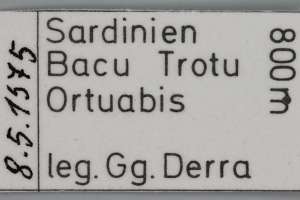2. Diagnose
2.1. Männchen
2.2. Erstbeschreibung
3. Weitere Informationen
3.1. Andere Kombinationen
- Gelechia nigritella Zeller, 1847 [Originalkombination]
- Eulamprotes nigritella (Zeller, 1847) [bis Huemer & Karsholt (2020) übliche Kombination]
3.2. Taxonomie
Huemer & Karsholt (2020) nehmen die Neukombination mit Oxypteryx vor, schreiben aber auch, dass noch Fragen offen sind: "Oxypteryx. Eulamprotes Bradley, 1971 with the type species E. atrella is shown to be a synonym of Oxypteryx Rebel, 1911 (Bidzilya et al. 2019), resulting in a number of new nomenclatural changes. We here propose the following new combinations: [...] Oxypteryx nigritella (Zeller, 1847) comb. nov. [...] Despite this new taxonomic approach, the genus is in strong need of revision. DNA barcodes separate into three clades seemingly supported by some morphological characters. For example, species formerly considered to be in the E. wilkella-group and characterized by the blackish ground colour of the forewings with silvery or whitish markings, form a separate clade. Further, the genus has an extraordinary intraspecific barcode variation with 18 sequenced species belonging to 27 BINs, with at least three yet unidentified species."
3.3. Faunistik
Gaedike & Heinicke (1999) machen darauf aufmerksam, dass frühere Meldungen zu dieser Art aus Deutschland in Wirklichkeit E. phaeella betreffen.
Karsholt & Huemer (2017: 177) melden die Art als neu für Kreta, können dabei aber bereits zahlreiche Belege von verschiedenen Fundorten auflisten.
(Autor: Erwin Rennwald)
3.4. Literatur
- Gaedike, R. & W. Heinicke (1999): Verzeichnis der Schmetterlinge Deutschlands (Entomofauna Germanica 3). — Entomologische Nachrichten und Berichte, Beiheft 5: 1-216.
- Huemer, P. & O. Karsholt (2020): Commented checklist of European Gelechiidae (Lepidoptera). — ZooKeys 921: 65–140. [zur Arbeit und PDF-Download auf zookeys.pensoft.net]
- Karsholt, O. & P. Huemer (2017): Review of Gelechiidae (Lepidoptera) from Crete. — Linzer biologische Beiträge, 49/1: 159-190. [PDF auf zobodat.at]
- Erstbeschreibung: Zeller, P. C. (1847): Bemerkungen über die auf einer Reise nach Italien und Sicilien beobachteten Schmetterlingsarten. — Isis von Oken 1847 (2): 121-159, (3) 213-233, (4) 284-308, (6) 401-457, (7) 481-522, (8) 561-594, (9) 641-673, (10) 721-771, (11) 801-859, (12) 881-914.




![Fragliches Vorkommen in Frankreich (europäisches Territorium ohne Korsika) [Vandromme et al. (2020): Liste systématique et taxinomique des Lépidoptères de France]](/res/img/flag/fr.gif)
![Fragliches Vorkommen auf Korsika [: Vandromme et al. (2020): Liste systématique et taxinomique des Lépidoptères de France mit KR kombiniert]](/res/img/flag/fr-cor.png)
![Vorkommen in Italien (Festland und kleine festlandsnahe Inseln) [Baldizzone et al. (1995): Checklist delle Specie della Fauna Italiana 83]](/res/img/flag/it.gif)
![Vorkommen auf Sardinien [Baldizzone et al. (1995): Checklist delle Specie della Fauna Italiana 83]](/res/img/flag/it-sar.png)
![Vorkommen in Sizilien [Baldizzone et al. (1995): Checklist delle Specie della Fauna Italiana 83]](/res/img/flag/it-sic.png)
![Vorkommen in Kroatien [Karsholt, Baldizzone & Gomboc (2023)]](/res/img/flag/hr.gif)
![Vorkommen auf Kreta [Karsholt & Huemer (2017)]](/res/img/flag/gr.gif)




